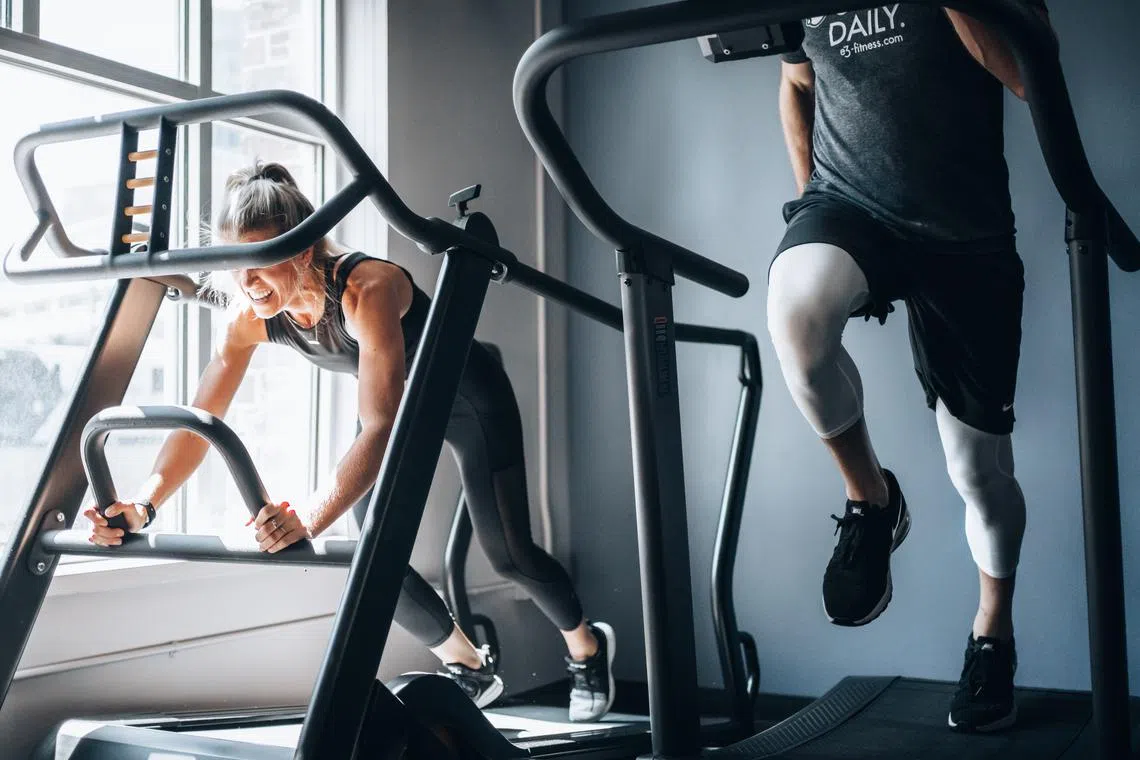Hitting the gym hard in 2024? Get tips from a specialist on how to prevent sports injuries
Sign up now: Get the biggest sports news in your inbox

ST speaks to a sports medicine expert on common sports-related injuries and how to prevent them.
PHOTO: UNSPLASH
Follow topic:
SINGAPORE - For those looking to get active as part of their new year’s resolutions for 2024, there is a nagging worry as they return to the gym, football field and badminton hall.
The risk of injury looms for all, whether they are student-athletes or weekend warriors.
The Straits Times speaks to Dr Cormac O’Muircheartaigh, medical director of the Sports Medicine Lab, for his expert insights into common sports injuries and how to prevent them.
1. Ankle sprains
By far the most commonly sustained sports injury is an inversion ankle sprain, where ligaments get strained due to a twisting injury such as landing from a jump while playing basketball. This is a form of acute injury, which occurs suddenly and is usually associated with severe pain.
According to Dr O’Muircheartaigh, the majority of ankle ligaments will naturally heal with a good rehabilitation programme. But to prevent them, a good dynamic warm-up and cool-down mobility routine is the ideal solution.
Dynamic mobility drills like hip circles, high stepping and lunges with a twist are great exercises to prepare the body for more strenuous activity. Here are seven dynamic warm-up stretches
2. Runner’s knee

For overuse injuries, a good regular strengthening programme stimulates muscle adaptation to stress, which strengthens it to withstand more load over time.
PHOTO: UNSPLASH
Also known as patellofemoral pain, this injury occurs due to accumulated load between the kneecap and the groove it glides in on the femur. This is a form of overuse injury that develops when a muscle, tendon, ligament, or bone is repeatedly stressed without adequate rest.
For overuse injuries, a good regular strengthening programme stimulates muscle adaptation to stress, which strengthens it to withstand more load over time. Some suitable knee strengthening exercises
3. Neck pain
Neck pain, or pain in the cervical spine, can be caused by sitting in a bad posture for prolonged periods and being immobile in school or at work. These ailments can have a spill-on effect while playing sports.
The simple correction for this is to move regularly during the day, says Dr O’Muircheartaigh. It is important to strengthen the lumbopelvic (lower back) region to improve postural stability. Stability exercises
4. Anterior cruciate ligament tears
An anterior cruciate ligament (ACL) rupture in the knee is one of the worst injuries an athlete can suffer, with recovery periods ranging between one to two years. These most commonly occur during sports that involve sudden stops or changes in direction such as football, basketball and skiing.
Dr O’Muircheartaigh says: “There are specific strengthening programmes that can reduce the risk of an ACL tear by more than 50 per cent. If you are involved in sports, you should be performing exercises that follow these programmes.”
These exercises focus on strengthening the hamstrings (hamstring leans), quadriceps (walking lunges) and also improving balance (toe raises). More details can be found here.
But if an ACL injury has already been sustained, Dr O’Muircheartaigh notes that there are rehabilitation protocols backed by research
He adds: “Not everybody is suitable for this protocol and it is quite a difficult protocol to follow, but it reinforces the fact that our body has an inherent incredible ability to heal and adapt!”
Tips to prevent injury
1. Combine static and dynamic stretching

Static stretching has not been consistently shown to reduce the risk of acute injury, according to research studies.
PHOTO: UNSPLASH
Static stretching has not been consistently shown to reduce the risk of acute injury, according to research studies. But rather a combination of static and dynamic exercises to prepare for training and exercise has been shown to reduce the risk of injury, says Dr O’Muircheartaigh.
2. Hydrate well and get enough sleep
Dehydration and fatigue increase the risk of acute injury. Extreme sports are at higher risk of acute injury, due to the nature of the sport. Skiing when fatigued increases the risk of injury so sleeping well in advance reduces the risk of injury.
3. Progressive training
Start gradually and respect the timeline that it takes for your body to adapt to exercise and training. Dr O’Muircheartaigh says: “Our bodies are amazing and capable of adaptation, repair and regeneration. But you have to respect tissue adaptation and healing timelines.
“Muscles will recover and adapt far quicker than tendons or ligaments will. Bones and cartilage will respond well to progressive training with overloading as well, but this repair takes time.”
4. Listen to your body
Take a recovery or rest day as part of adaptation. Enjoy the fitness journey as it is investing in your physical and mental wellbeing for your future.

